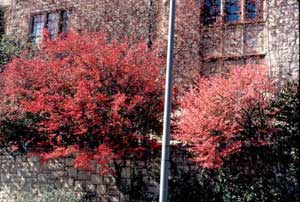Landscape Shrubs
Winged Euonymus (Burningbush)
(Euonymus alatus)
It is rare to find plants that are main components of landscapes in almost every part of the U.S. including the deep South, but burningbush (Euonymus alatus) is one of them. Like forsythia and floweringquince (Chaenomeles), burningbush appears to be one of those bread & butter deciduous plants that are adaptable enough to tolerate a wide range of environmental situations.
Burningbush is a fairly versatile deciduous plant from its landscape value to tolerance of sun and shade. The texture on burningbush is clearly medium due to refined branches and delicate medium green leaves. One of the other common names for burningbush is the winged Euonymus. This later common name clearly describes the pronounced corky ‘wings’ that are visible on most twigs. Even in the dead of winter this plant is easy to identify from the pronounced corky ‘wings’. For photographers, this is a key plant to watch in winter when light dustings of snow highlight the artistic ‘winged’ branches.
While the summer leaf color is a medium green, in the fall this is one shrub that lights up our landscape with reliable and brilliant soft pink fall color. The exceptional fall color explains the other frequently cited common name, burningbush.
Flowers on burningbush are typical of other Euonymus and are therefore not showy. Individual flowers are small (less than ¼” in diameter) and a yellow-green color that blends into the green leaves. Collectively the small flowers are born on a cyme. Flowering is typically in early April just after the plant leafs out. The fruit, which is a dehiscent capsule, is surprisingly not that showy. The beauty in the fruit is not the outer capsule wings but the vivid, inner, orange seeds. Unlike other Euonymus, the fruit display lacks that “wow” factor and this may be due to the arrangement of leaves and fruits or the timing of leaf and fruit drop. Although invasiveness is not an issue in Arkansas, this plant is considered ‘weedy’ in many eastern states.
Burningbush would be classified as a medium to large shrub. Most specimens tend to be 9-10’ tall with a similar spread. A primary justification for many cultivars is for reduced plant size although this can sometimes be misleading. A clear example is the cultivar ‘Compactus’. While the cultivar name might suggest a dwarf plant, this selection clearly does not represent a significant reduction in plant size. ‘Compactus’ clearly distinguishes itself from the species by having a brilliant fire red fall color. Most plants used in Arkansas tend to be one of the semi-dwarf cultivars such as ‘Rudy Haag’ or ‘Nordine Strain’. These cultivars tend to be about 5’ tall. The cultivar Chicago FireTM is marketed as having superior crimson fall color but it is hard to imagine having more intense color than what is seen on ‘Compactus’.
Unlike evergreen Euonymus, it is rare to observe any significant disease or insect problems on burningbush. While burningbush is known for tolerating landscape situations from full sun to dense shade in the North and East, in Arkansas the plant is best suited in partial sun to dense shade. Premature fall color results on plants situated in full sun. The preferred soil should be a rich soil with consistent and adequate moisture. This is not a drought tolerant plant. Although an uncommon use in the South, this plant is frequently used as a sheared, deciduous hedge in other parts of the country.
- Common Name: burningbush, winged Euonymus
- Varieties to look for: ‘Rudy Haag’
- Flower Color: yellow, insignificant
- Blooming period: early April
- Type: deciduous shrub
- Size: 9’ tall by 9’wide
- Exposure: shade to partial sun
- Soil: well drained, slightly acid
- Watering: consistent moisture
- When to prune: as needed
- Suggested use: foundation, mixed shrub border, hedge
Form
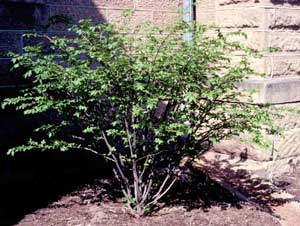
Hedge form
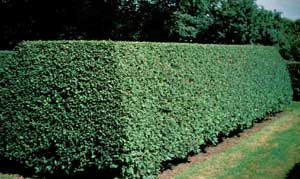
Compactus' cultivar form with fall color
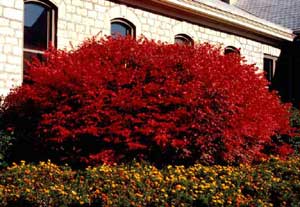
'Compactus' cultivar twigs
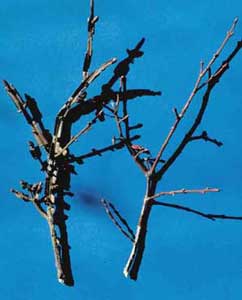

Flower and leaf structure
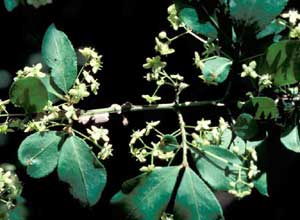
Twig structure
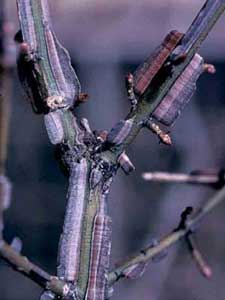
'Compactus' fall colors
